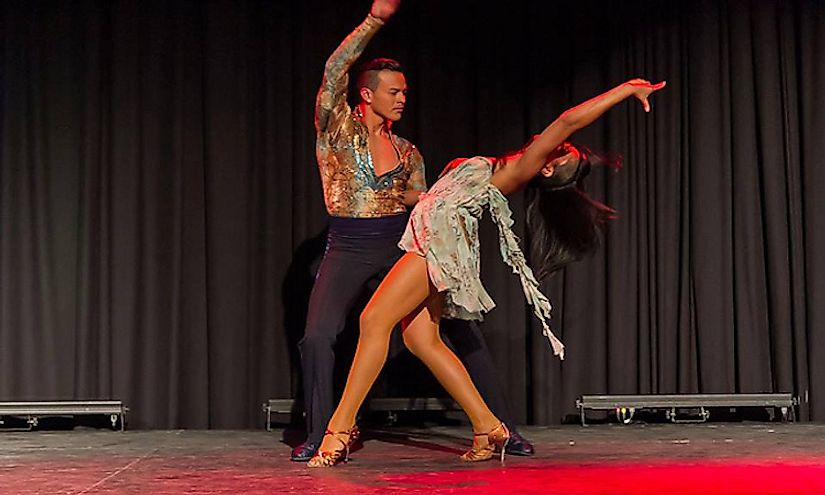More About Dance San Francisco
Wiki Article
5 Easy Facts About Dance San Francisco Explained
Table of ContentsDance San Francisco Things To Know Before You Get ThisThe smart Trick of Dance San Francisco That Nobody is DiscussingHow Dance San Francisco can Save You Time, Stress, and Money.Dance San Francisco Fundamentals ExplainedDance San Francisco Can Be Fun For EveryoneDance San Francisco for DummiesThe Ultimate Guide To Dance San Francisco
The significant distinction that differentiates the Miami-style from various other North American designs is the "Atras" or "Angled", back breaking steps carried out in reverse diagonally as opposed to moving forwards and backwards as seen in the New york city design. Dancers do not shift their body weight substantially as seen in other designs. bay area salsa dancing. Rather, professional dancers maintain their top body still, poised and loosened up, concentrating on foot activityA significant difference between Cali Style and Miami-style is the last is solely danced on the downbeat (On1) and has aspects of lusters and show-style added to it, adhering to collections of North American styles. Miami-style has several adherents, particularly Cuban-Americans and other Latinos based in South Florida.
Much of the actions include swiftly exchanging companions. "Rueda de Cuba" is initial kind of Rueda, originating from Cuba. It is not as formal as Rueda de Miami and is composed of regarding 30 calls. [] It was ordered in the 1970s. [] "Rueda de Miami" come from in the 1980s from Miami, is an official style with several regulations based on a mix, and is a hybridization of Rueda de Cuba & North American dancing designs, with some routines mirroring American society (e.
An Unbiased View of Dance San Francisco
Coca-Cola, Dedo, Adios) which is not located in the traditional Cuban-style Rueda - bay area salsa dancing. Cali-Style Salsa, additionally called Colombian Salsa and Salsa Calea, is based around the Colombian City of Cali. Cali is likewise referred to as the "Funding de la Salsa" (Salsa's Funding); as a result of salsa music being the major style in parties, bars and celebrations in the 21st century.The aspects of Cali-Style Salsa were strongly affected by dances to Caribbean rhythms which came before salsa, such as Pachanga and Boogaloo. Cali has the highest possible number of salsa schools and salsa groups in the world. Many of the competitors are kept in Colombia. The main feature is the footwork which has quick fast steps and missing activities called "repique".
published here
The smart Trick of Dance San Francisco That Nobody is Discussing
They consist of numerous acrobats such as partnered flips to delight with these jaw dropping stunts. Their footwork is complex and specific, aiding several Colombian Style dancers win significant globe champions. Cali hosts many yearly salsa occasions such as the World Salsa Cali Festival and the Encuentro de Melomanos y Coleccionistas.Scientists in the all-natural sciences studied the mathematics of salsa dancing steps. In the social sciences, researchers have studied salsa dancing to comprehend, as an example just how the Latino identification is connected to salsa dancing. The study of salsa dance has actually been researched as a allegory to recognize psychological and social economies.
and, scientists have also made use of salsa dancing to research the ephemerality of social groups. Salsa songs the music to which salsa is danced Mambo a dance style which greatly influenced salsa dancing Palladium Ballroom a New York City venue that aided promote Latin songs and dance throughout the 1940s and 1950s Dance a ballroom dance that greatly influenced salsa World Salsa Championships a checklist of global competitions for salsa dancing Cuban salsa a preferred type of salsa dance from Cuba Boggs, Vernon (1992 ).
All About Dance San Francisco
ISBN 0-313-28468-7. OCLC 24908952. Hutchinson, Sydney (2004 ). " Mambo on 2: The birth of a new form of dancing in New York City" (PDF). Centro Journal. 16: 108137. ISSN 1538-6279. " What Is Salsa (Dance)?". 2023-03-13. Recovered 2023-05-26. Youthful, Takeshi (26 June 2023). " Latin Dance". Salsa Vida. Retrieved 5 October 2023. " Creating salsa".Salsa Vida. 26 June 2023. Fetched 5 October 2023.
Salsa Vida. Movers and Shakers Salsa & Bachata Dance Academy. Spinning Mambo Into Salsa.
Fetched 2019-06-26. Waxer, Lise Aerinne (2002 ). The city of music memory: salsa, record grooves, and preferred society in Cali, Colombia. Music/culture. Middletown, Conn: Wesleyan University Press. ISBN 978-0-8195-6441-2. " Colombian Design Salsa". Salsa Vida SF. Obtained 27 July 2020. von Renesse, Christine; Ecke, Volker (2011-03-01). " Maths and Salsa dancing". Journal of Maths and the Arts.

Dance San Francisco Things To Know Before You Buy
9 (2 ): 113125. doi:10. 1002/cb. 308. Holmqvist, Jonas; Diaz Ruiz, Carlos; Pealoza, Lisa (2020-08-01). " Minutes of deluxe: Hedonic escapism as a deluxe experience". Journal of Company Study. 116: 503513. doi:. ISSN 0148-2963. S2CID 211427257. Diaz Ruiz, Carlos A.; Penaloza, Lisa; Holmqvist, Jonas (2020-01-01). " Setting up tribes: An assemblage thinking method to the characteristics of ephemerality within customer tribes".
Something went incorrect. Wait a minute and try once again Attempt again.
The Basic Principles Of Dance San Francisco
We're speaking about the dancing, not the tasty South American dressing. The beginnings of words "Salsa" as the name of a dancing has provided debate for decades. One of the most popular (and potentially accepted) theory is that Cuban and Puerto Rican artists in New york city created the phrase in New York in the 1970's, to define the spicy blend of music they were developing out of the rhythms and motifs of Cuban son montuno, guaracha, chachacha, mambo and bolero.Report this wiki page